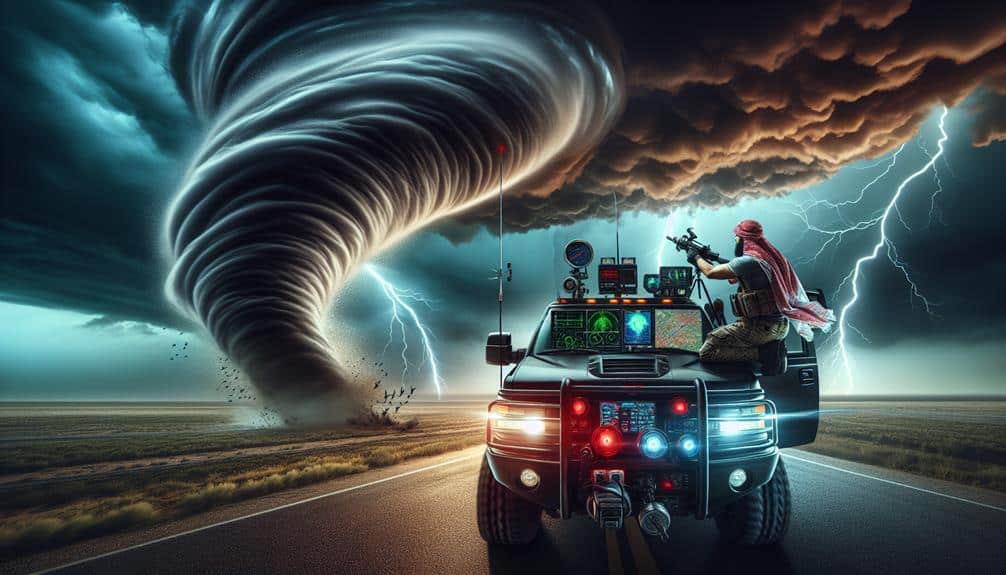Analyzing storm structure is crucial for effective risk assessment as it allows us to identify potential hazards and predict storm trajectories accurately. By studying temperature variances, moisture levels, and vertical wind shear, we can anticipate strong winds and flooding risks. Advanced tools such as Doppler radar and satellite imagery assist us in monitoring storm intensity and lightning activity, guiding emergency planning and resource allocation. This data-driven approach guarantees timely responses, improves public safety, and validates budget allocations. Understanding the complexities of storm behavior enables us to optimize our emergency protocols and protect communities. Let's delve into how these strategies converge.
Key Points
- Understanding storm structure helps identify vulnerable areas for targeted resource allocation.
- Analyzing storm structure reveals wind patterns and precipitation rates critical for flood risk prediction.
- Detailed storm structure analysis aids in the identification of high-risk zones for effective emergency planning.
- Tracking storm dynamics and intensity supports timely and informed emergency response actions.
Understanding Storm Dynamics
To effectively assess storm risks, we must first explore the intricate dynamics governing storm formation and behavior. Understanding these dynamics begins with a detailed examination of atmospheric conditions. Atmospheric conditions such as temperature gradients, humidity levels, and wind patterns play pivotal roles in storm formation. By analyzing these parameters, we can predict how and where a storm might arise.
We need to examine the interaction between different atmospheric layers. For instance, the troposphere's instability can lead to the development of cumulonimbus clouds, which are often precursors to severe storms. Additionally, the presence of jet streams can significantly impact storm intensity and trajectory.
Moreover, data from satellite imagery and weather radar systems provide us with real-time insights into storm formation processes. By integrating this data with numerical weather prediction models, we enhance our ability to anticipate storm behavior accurately.
Thus, our focus on the foundational aspects of storm dynamics enables us to evaluate risks with greater precision. By understanding the specific atmospheric conditions that contribute to storm formation, we can better prepare for potential weather-related events, empowering us to take informed and decisive actions.
Identifying Potential Hazards
Identifying potential hazards involves systematically analyzing storm-associated risks such as flooding, strong winds, and lightning strikes. By conducting thorough structural analysis, we can pinpoint vulnerabilities within the storm system that may lead to significant damage.
For instance, studying the vertical wind shear helps us understand the likelihood of strong winds that can uproot trees and damage infrastructure.
Flooding risk assessment is pivotal as well. Analyzing precipitation patterns and runoff models allows us to predict areas prone to inundation, thereby facilitating targeted emergency planning.
Lightning strikes, often overlooked, are also essential; by mapping lightning activity, we can identify zones with elevated risk, helping to safeguard both people and property.
Our approach to hazard identification isn't just about recognizing immediate threats, but also about understanding their potential impact on the broader community. We integrate these insights into our emergency planning strategies, ensuring that resources are allocated efficiently and effectively.
Predicting Storm Paths
Predicting storm paths involves utilizing meteorological models and real-time satellite data to accurately forecast the trajectory and intensity of severe weather systems. By employing advanced tracking methods, we can analyze satellite imagery and radar technology to pinpoint the movement of storms. This approach allows us to anticipate the potential impact areas and warning timeframes more precisely.
Climate modeling plays an essential role in these predictions. By simulating various atmospheric conditions, we can generate potential storm paths and assess their likelihood. This data-driven method is vital for understanding how changes in climate patterns influence storm trajectories. High-resolution satellite imagery offers a real-time visual representation of storm development, providing important insights into their evolving structure.
Additionally, radar technology enhances our ability to monitor storm intensity and movement. Doppler radar, for instance, measures velocity patterns within a storm, allowing us to detect changes in wind speed and direction. Combining these technologies, we create detailed models that can predict storm paths with greater accuracy.
Our goal is to empower communities with timely, precise information, enabling them to make informed decisions and safeguard their freedom and safety. By refining our tracking methods and employing state-of-the-art technology, we enhance our capability to predict storm paths effectively.
Assessing Storm Intensity
When evaluating storm intensity, we prioritize wind speed measurement and precipitation rate analysis. By employing anemometers and Doppler radar data, we can quantify wind velocities with precision.
Additionally, analyzing precipitation rates using satellite and ground-based sensors allows us to determine the storm's potential impact on infrastructure and safety.
Wind Speed Measurement
To accurately assess storm intensity, we rely on precise wind speed measurements obtained through advanced meteorological instruments and methodologies. Doppler radar and anemometer readings form the backbone of our data collection efforts.
Doppler radar allows us to measure wind velocity at various altitudes within a storm system, providing real-time data on wind patterns and potential storm development. This radar technology emits microwave signals that bounce off rain droplets, enabling us to calculate wind speed and direction with remarkable accuracy.
Anemometers, on the other hand, provide ground-level wind speed data, critical for understanding surface wind dynamics. These instruments, often mounted on weather stations, measure wind force and velocity, giving us granular insights into the storm's immediate impact area.
By integrating anemometer readings with Doppler radar data, we achieve a comprehensive view of the storm's wind structure. This dual approach not only enhances our ability to predict storm behavior but also aids in issuing timely warnings, thereby granting communities the autonomy to prepare and respond effectively.
Accurate wind speed measurements are imperative for evaluating potential damage, ensuring public safety, and mitigating risks associated with severe weather events.
Precipitation Rate Analysis
Complementing our wind speed measurements, analyzing precipitation rates provides another important layer of data for evaluating storm intensity. By examining precipitation rates, we can determine how much rain or snow a storm will deliver over a specific period. This analysis is vital for accurate radar interpretation and weather forecasting.
To effectively analyze precipitation rates, we should focus on:
- Radar Interpretation: Using Doppler radar, we can measure the intensity and duration of precipitation. This data helps us predict where and when heavy rainfall will occur.
- Weather Patterns: Understanding recurring weather patterns allows us to forecast storm behavior, including precipitation intensity. Recognizing these patterns aids in predicting future storms with similar characteristics.
- Flood Risk Assessment: By analyzing precipitation rates, we can estimate potential flood risks. High precipitation rates over short periods can lead to flash floods, while sustained rates over longer periods can cause river flooding.
- Data Integration: Combining precipitation data with wind speed measurements and other meteorological data provides a complete picture of storm intensity. This integrated approach enhances the accuracy of our weather forecasting models.
Informing Emergency Responses

When we analyze storm structure, we can utilize real-time data to enhance emergency responses.
This allows us to allocate resources efficiently, ensuring that aid reaches the most affected areas promptly.
Real-Time Data Utilization
Real-time data utilization critically enhances the accuracy and timeliness of emergency response strategies during severe storms. By leveraging cutting-edge data visualization and predictive modeling techniques, we can make informed decisions that protect lives and property. These tools allow us to see storm patterns as they develop, enabling prompt and precise action.
Here's how real-time data benefits emergency responses:
1. Immediate Threat Identification:
With up-to-the-minute data visualization, we pinpoint storm systems' exact locations and predict their paths, guaranteeing timely alerts to affected communities.
2. Predictive Modeling for Evacuations:
Predictive modeling helps us forecast potential impact zones, guiding evacuation plans and minimizing chaos by directing people away from harm.
3. Resource Deployment:
Real-time data informs us where to send emergency services, such as ambulances and rescue teams, optimizing their effectiveness and reducing response times.
4. Public Communication:
Accurate, real-time updates distributed via multiple platforms guarantee that the public receives reliable information, empowering them to make safe, informed decisions.
Resource Allocation Efficiency
Effective resource allocation relies on accurate, data-driven insights to optimize emergency response efforts during severe storms. By analyzing storm structure, we can conduct precise risk evaluation and enhance both budget planning and response coordination.
When we grasp storm dynamics, we can forecast which areas will be most impacted, allowing for targeted resource allocation. This accuracy guarantees that we're not squandering time or money on low-risk zones, thereby maximizing the impact of our efforts.
Advanced modeling techniques and real-time data integration enable us to develop detailed risk maps. These maps enlighten us on potential damage scenarios, assisting us in prioritizing resource distribution.
For example, we can assign more emergency personnel and medical supplies to high-risk areas, guaranteeing swift response to the most critical locations. This not only preserves lives but also conserves limited resources.
Furthermore, data-driven insights empower us to justify budget allocations more effectively. When we present clear, evidence-based risk assessments, it's simpler to secure funding and make well-informed budget planning decisions.
Essentially, precise storm structure analysis enhances our capability to allocate resources efficiently, ensuring that our emergency responses are both impactful and economically sustainable.
Public Safety Measures
By leveraging our precise storm structure analysis, we can implement targeted public safety measures that inform and enhance emergency responses. Accurate storm data allows us to develop effective emergency protocols, ensuring timely and organized reactions to imminent threats. This approach maximizes our ability to protect lives and property while empowering communities to make informed decisions.
Here are four key ways that storm structure analysis informs our public safety measures:
- Customized Emergency Protocols: By understanding the specific characteristics of a storm, we can create tailored emergency protocols that address unique risks and optimize resource deployment.
- Enhanced Community Awareness: Detailed storm structure analysis enables us to provide precise, real-time information to the public, fostering heightened community awareness and prompt, appropriate actions.
- Optimized Evacuation Routes: Analyzing storm patterns helps us identify the safest evacuation routes, minimizing congestion and ensuring efficient movement away from danger zones.
- Targeted Resource Allocation: With accurate data, we can strategically position emergency services, medical aid, and supplies where they're most needed, reducing response times and improving overall effectiveness.
Enhancing Safety Measures
To greatly enhance safety measures, we must integrate advanced predictive analytics and real-time data processing into our storm risk assessment protocols. By leveraging these technologies, we can refine our safety protocols and improve risk mitigation strategies. Predictive analytics enables us to forecast storm behaviors more accurately, identifying potential threats before they materialize. This foresight is essential for preemptive evacuations and resource allocation.
Real-time data processing, facilitated by high-speed computing and IoT devices, allows us to monitor storm developments as they happen. We can track changes in wind speed, precipitation, and atmospheric pressure, providing a dynamic and updated risk profile. This immediate information empowers decision-makers to adjust safety measures on the fly, ensuring communities aren't only prepared but also responsive to evolving conditions.
Moreover, using machine learning algorithms, we can analyze historical storm data to identify patterns and anomalies. This helps in crafting more efficient safety protocols tailored to specific storm types and regions. Ultimately, our goal is to minimize risk and enhance community resilience.
Frequently Asked Questions
How Do Weather Satellites Contribute to Storm Structure Analysis?
Satellite imagery and radar technology, though distinct, work in tandem to enhance our storm structure analysis. We capture real-time data, track storm evolution, and predict impact zones, empowering us with actionable insights for enhanced risk assessment.
What Role Do Computer Models Play in Storm Risk Assessment?
We rely on computer models for storm risk assessment because they enhance model accuracy and facilitate data integration. These models amalgamate vast datasets, improving our predictive capabilities and enabling precise, timely decision-making for effective risk management.
How Is Historical Storm Data Used in Current Risk Assessments?
Using historical storm data is like having a roadmap; it enhances data interpretation and risk management. By examining climate trends, we bolster disaster preparedness, enabling us to predict and mitigate future hazards with precision and expertise.
What Are the Economic Impacts of Better Storm Structure Analysis?
By improving storm structure analysis, we can enhance risk assessment, leading to more accurate predictions. This precision reduces economic impacts by minimizing damage, optimizing resource allocation, and ensuring businesses and communities can better prepare and recover swiftly.
How Are Communities Educated About the Findings From Storm Risk Assessments?
We conduct community outreach and public education by utilizing data-driven presentations, workshops, and online resources. This empowers communities to understand the findings, make informed decisions, and enhance their resilience against potential storm risks.


